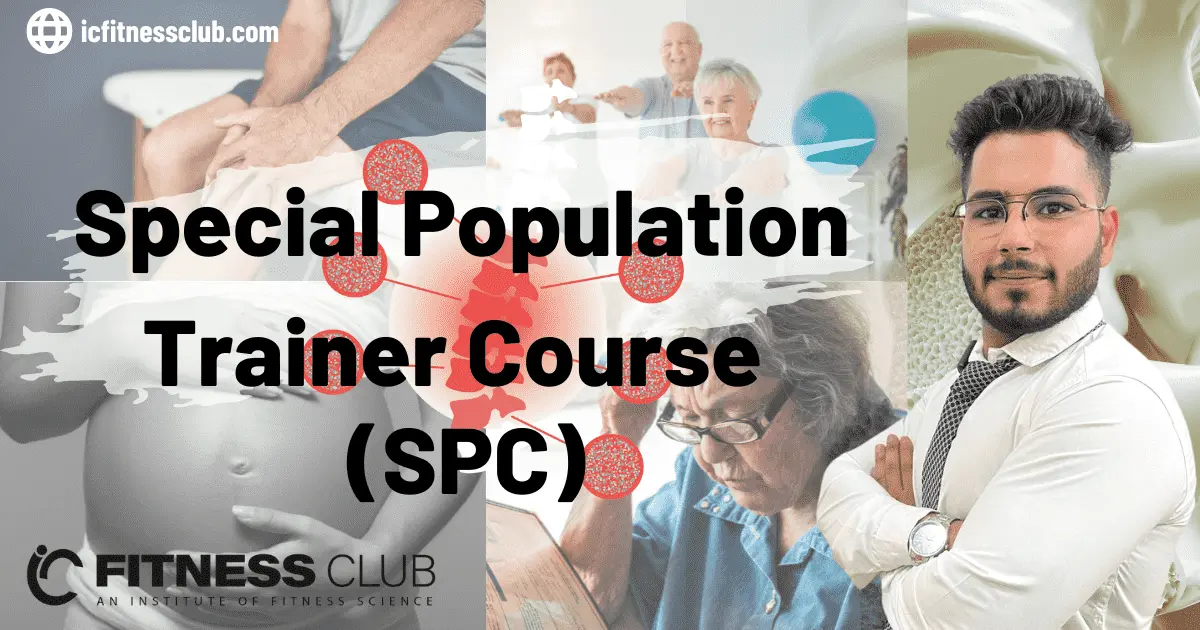Personal Trainer for Special Population Course (SPC)
As we all know the human body is a very complicated structure. It comprises of many different types of joints and tissues. The well-being of the Entire human body is necessary to live in the best way and to enjoy each and every moment.
The human body can suffer from many injuries or issues related to organs, tissues, joints, and bones, which will impact the level of living of a human being. This will also affect day to day activities of the person.
Personal Trainer for a special population makes personal trainers tackle various musculoskeletal and metabolic disorders which can be acute or chronic.
PT for special populations prepares personal trainers to strengthen the body and increase the physical performance of the people despite their medical issues.
To apply for this course DPT is compulsory.
Syllabus
Chapter – 1 Musculoskeletal Condition and Disorders
- Disorders of the Spine and Associated Musculature
- Disorders of the Skeletal System
- Disorders of Joint Structures
- Disorders of the Muscular System
Chapter – 2 Metabolic Conditions and Disorders
- Obesity
- Type 2 Diabetes Mellitus
- Type 1 Diabetes Mellitus
- Dyslipidaemia
- Hypothyroidism and Hyperthyroidism
- Chronic Kidney Disease
Chapter – 3 Pulmonary Disorders and Conditions
- Asthma
- Pulmonary Hypertension
- Chronic Obstructive Pulmonary Disease
- Chronic Restrictive Pulmonary Disease
- Cystic Fibrosis
Chapter – 4 Cardio Vascular Conditions and Disorders
- Hypertension
- Peripheral Arterial Disease
- Angina
- Chronic Heart Failure
- Myocardial Infarction
- Atrial Fibrillation
- Pacemakers and Implantable Cardioverter Debrillators
- Valvular Disorders
- Cardiovascular Surgical Procedures: Coronary Artery Bypass Graft and Percutaneous Transluminal Coronary Angioplasty
Chapter- 5 Cancer
- Pathology of Cancer
- Pathophysiology of Cancer
- Specific Management and Treatment of Individuals With Cancer
- Common Medications Given to Individuals With Cancer
- Effects of Exercise in Individuals With Cancer
- Exercise Recommendations for Clients With Cancer
Chapter – 6 Immunologic and Hematologic Disorders
- Rheumatoid Arthritis
- Lupus
- Chronic Fatigue Syndrome
- Fibromyalgia
- HIV/AIDS
- Sickle Cell Disease
- Haemophilia
Chapter – 7 Neuromuscular Conditions and Disorders
- Multiple Sclerosis
- Parkinson’s Disease
- Muscular Dystrophy
- Cerebral Palsy
- Traumatic Brain Injuries
- Stroke
- Spinal Cord Injuries
- Epilepsy
Chapter – 8 Cognitive Conditions and Disorders
- General Exercise Considerations for Clients with Cognitive Disorders
- Exercise Recommendations for Clients with Cognitive Conditions and Disorders
- Autism Spectrum Disorder
- Down Syndrome
- Intellectual Disability
- Dementia and Alzheimer’s Disease
- Philosophy of Exercise Programming for Clients with Special Needs
Chapter – 9 Children and Adolescents
- Benefits of Physical Activity for Children and Adolescents
- Growth, Maturation, and Physical Activity
- Effects of Exercise on Children and Adolescents
- Exercise Recommendations for Children and Adolescents
Chapter – 10 Older Adults
- Exercise Recommendations for Older
- Common Medications Given to Older Adults
- Effects of Exercise on Older Adults
- Exercise Recommendations for Older Adults
- Recommended Strategies for Instructing Older Adults
Chapter – 11 Female-Specific Conditions
- Female Athlete Triad
- Pregnancy and Postpartum
- Menopause and Postmenopause
- Fitness Assessments & Health Screening
Total Duration – 5 Months



